Strengthening Food Safety: Expert Solutions for Compliance and Outbreak Prevention
Maintaining food safety is an ongoing challenge across the food production and processing industries. Our latest technologies and recommendations are designed to strengthen food safety protocols, reduce contamination risks, and maintain compliance with evolving standards.

Strengthening Food Safety: Expert Solutions for Compliance and Outbreak Prevention
With rising risks from pathogens like Salmonella, E. coli, and Listeria and growing pressure from FDA recalls, food processors are tasked with elevating sanitation standards. Regulations under the Food Safety Modernization Act (FSMA) demand preventive controls, rigorous traceability, and effective sanitation programs.
CFS Technologies’ food safety solutions start well before the production floor, extending from agricultural sources to distribution logistics. Our latest technologies and recommendations are designed to strengthen food safety protocols, reduce contamination risks, and maintain compliance with evolving standards.
Key Sanitation Strategies for Food Safety Compliance
1. Strengthen Preventive Controls
The FSMA HACCP standards mandate proactive hazard identification and risk-based preventive controls that include:
- Structured sanitation cycles using reliable cleaning and sanitizing chemical applicators designed for the intended task.
- Cross contamination prevention for critical control points leading into food handling zones.
- Employee hygiene enforcement including cleaning and sanitizing protocols for hands, gloves, boots.
- Facility inspection protocols.
- Use reliable, approved cleaning and sanitizing chemicals according to the manufacturer’s instructions.
Pro Tip: Conduct regular staff training and facility audits to stay FSMA compliant.
2. Design for Cleanability and Compliance
Sanitary design and maintenance is foundational for preventing bacterial harborage:
- Corrosion-resistant, sanitary, stainless steel dispensing equipment by CFS Technologies ensures durability in wet environments.
- Weld points and flat surfaces should be smooth and maintained to prevent gaps or pockets where moisture can collect and promote bacterial growth.
- Stable water pressure is essential for consistent chemical ratios when using Venturi chemical applicators. Select applicators designed for the available water pressure and which can provide reliable dilution ratios across a range of water pressures.
- For the most precise chemical dilution control, implement a central chemical feed system to supply foam and sanitizer applicators with precisely diluted chemicals.
Recommended: Implement automated chemical dispensing systems where practical; practice good preventive maintenance with all application equipment and accessories; schedule periodic water-quality assessments.
Advanced Tools for Reliable Sanitation
Foam, Spray, and Fogging Systems
To prevent outbreaks via a HACCP-compliant plan, CFS Technologies offers:
- Foam cleaning systems for extended dwell times and thorough surface coverage.
- Spray sanitizer systems with lean ratios for practical no-rinse applications.
- Foggers to sanitize hard-to-reach spaces and provide a final layer of protection.
Each type of system is available as a stand-alone venturi system or as a Pump Fed system designed for use with a central chemical feed system. The venturi systems are complete balanced systems designed to achieve the maximum vacuum level so, when properly installed, the systems produce acceptable dilution ratios despite common fluctuations in water pressures.
Entryway & Environmental Controls
Critical entry points must be managed with precision:
- Lafferty entryway foam systems help prevent cross contamination at critical control points leading into clean zones.
- These systems deliver consistent applications of sanitizing foam via regular, timed intervals or on an as-needed basis via remote, push button activation or electronic sensors.
- Lafferty Entryway Foam Sanitizers are available as compressed-air assisted systems or “airless foam” systems. They are configured as either venturi applicators or pump-fed applicators that work with a central chemical pumping system.
Sustainable and Cost-Efficient Operations
With sustainability regulations gaining traction, processors must:
- Reduce chemical and water waste with precision dosing and low-pressure application systems.
- Install flow restrictors and optimized nozzles to cut rinse water consumption by over 50 percent.
- Use equipment aligned with USDA environmental guidelines.
Optimize Your Sanitation Program with CFS Technologies
Food safety is non-negotiable. Preventing outbreaks, complying with FSMA, and reducing contamination risks demands a proactive approach. Whether you manage sanitation, operations, regulatory compliance, or facility maintenance, CFS Technologies offers the expertise and solutions to protect your plant and product integrity.
Ready to future-proof your sanitation program? Contact us today for a comprehensive Food Safety Assessment and Expert Consultation.
.png)

